Check out this amazing weighted lap pad guide to help improve attention, focus, or calming from an occupational therapist, whether your child has autism, sensory processing disorder, or no diagnosis at all!
Don’t you just love a great sensory hack or trick? You know some simple activity or tool that can be a total game changer for your child because it gives them sensory input they couldn’t tell you they needed.
As a mom, and definitely as an occupational therapist, I sure do.
Today, I want to talk to you about the magic the weighted lap pad can hold for some kids. Of course, as with all sensory tools, this isn’t one size fits all.
Let’s break it down: what is a weighted lap pad, why are kids using them, exactly how do you use one with your child, and different types including some DIY weighted lap pads you can make in no time!
What is a Weighted Lap Pad?
Like a lot of sensory tools and toys, a weighted lap pad isn’t exactly in the average home’s vocabulary. And, honestly, it does sound a bit strange, but it’s actually quite simple. A weighted lap pad is a heavy pillow of varying shapes and sizes that fits across a child’s lap.
A rectangle is the classic shape, but bolsters, tubes, circles, and irregular animal shapes also will make appearances. The shape doesn’t matter, but how heavy it is and how much of your child’s lap it covers might.
They can be helpful for kids that have no diagnosis at all, but have some sensory issues or kids with autism, ADHD, sensory processing disorder, or anxiety.
When weighted lap pads are effective, they help kids sit still better and can be a great support in the classroom, library story time, or the dinner table! Basically anywhere your child has trouble sitting still.
Why are Kids Using Weighted Lap Pads – Is it right for my kid?
The reason weighted lap pads can be such a powerful tool is that the weight of the pad or pillow can be really calming and organizing (that means it helps them focus better) for some kids. This is because it gives proprioceptive input.
It’s very similar to the idea of a weighted blanket. Head over to the total guide for weighted blankets to learn more.
In particular, kids that seek out or respond to proprioceptive input are often good candidates for trying a weighted lap pad. These kids are often described as wiggly, have difficulty sitting still, or wild.
But, some kids that seek out proprioception avoid tactile sensations and there’s no getting around that weight can also stimulate the tactile system.
Signs that your child doesn’t like similar tactile sensations could be a child that doesn’t like having blankets on them in the bed, or wearing extra clothes. In this case, even though a child seeks out proprioception (say through jumping and crashing activities), they may not be a good candidate for a weighted lap pad.
However, each kid is so unique and with all the fun different textures and colors that you can make or buy, your child still might respond really well to one.
When I’m working with a kid that has sensory needs, I don’t just give them a weighted lap pad because I think they’re cool, I go through a thought process to decide if I think it will actually be helpful. It looks like this:
- Does the child have difficulty sitting still for organized activities?
- Does the child have difficulty sitting still for any activity?
- Does the child have difficulty transitioning between activities (i.e. time to go to the store, time to take a bath, etc.)
- Does the child have difficulty being in public or social settings?
- Does the child have difficulty going to sleep?
- Does the child have anxiety or difficulty relaxing?
- Does the child seem to seek out rough or wild playing like jumping, climbing, or deep pressure in some way on their body?
If you answered no to all of these questions, a weighted lap pad likely wouldn’t help your child’s needs, although this isn’t a totally exhaustive list, there surely are other circumstances where it could apply. However, if you answered yes to any of the questions, then we need to take it a step further:
- Does the child have tactile defensiveness and doesn’t like objects or fabrics like bed sheets being on them?
- Does the child seem to shy away from heavy objects, jumping activities, or seem lethargic or apathetic often?
If you answered yes to either of these questions, especially the latter, then this sensory hack may not be a good fit for your child.
How to Use a Weighted Lap Pad
This is a sensory tool that shouldn’t be used all day long, but for times that your child has difficulty sitting still, or simply wants to calm down and relax. Since it lays across their lap, you’ll give it to them or place it on them for most seated activities. Having said that, some of the different types of weighted lap pads you’ll see below can also be used to wrap around their shoulders or their neck.
And, if you’re using this a tool to help your child calm down, they can use it while lying down as well, perhaps in a sensory tent?
Generally speaking, it’s always best to allow your child to decide how long they want to “wear” the pad or pillow, but as a rule of thumb, 20 minutes is a good time frame. For younger kids, they may not voice if it’s uncomfortable or too heavy, so I’d recommend starting off in 5-minute increments. And, honestly, 5-7 minutes is all some kids need.
ALWAYS respect when a child doesn’t want to use a weighted lap pad anymore. And, the weight shouldn’t be so heavy that they can’t remove it from their lap themselves. (See the weight guidelines below).
I most often use a weighted lap pad during:
- Mealtimes (for the kids that keep falling out of their chair, fidgets constantly, or is always get up out of their seat)
- Learning activities (puzzles, school activities that must be completed at a desk, coloring, etc.)
- Circle time at school, daycare, or the library (for kids that keep getting up, rolling over, or are disruptively fidgety)
- In the car (for the kid that hates car rides or is anxious about going somewhere)
- When changing activities (for the kid that tantrums and melts down when it’s time to do something different, they can carry it or wrap it around their neck)
- During haircuts (for the kid that is irritated by the buzzers, scissors, or flying hair)
- When cutting nails (for the kids that screams and has a major meltdown)
- For teeth brushing (for the kid that can’t stand it, have them sit with it on their lap, let them hold it, or wear it around their neck)
- In social settings like birthday parties with crafts and sit down activities
- In the grocery cart (for kids that are overwhelmed by the lights, sound, or environment of a store)
- When playing in a sensory bin (for kids that don’t like to get messy, this can be calming input that helps them explore the texture of the sensory bin)
- For bedtime/sleeping (for kids that have a hard time getting to sleep or falling asleep, allow them to hold or place it where it feels comfortable. But, not recommended for children under 3 during sleep)
- In a quiet spot, a sensory tent, or while relaxing on the couch (for kids that have difficulty calming down or may be described as hyperactive.)
Some weighted pads have the added feature of textured fabrics, bright colors, or tags and other fidgets sewn on so that a child can also feel the weighted lap pad. This extra sensory input really matters in this being a successful sensory hack for some kids.
Keep in mind that even if your child loves their weighted lap pad one day, they may not the next. This is okay and totally normal. Sensory needs fluctuate from day to day, even hour to hour. Most kids benefit from giving them a choice to what will help them.
Let’s take my son, for example, Isaac. He seeks proprioceptive and tactile input, loves it!
Before dinner, where he often rocks on his chair, gets up and down, and even pulls his knees up and pushes them against the table (hello proprioceptive input), I might ask him: “Would you like to use your weighted lap pad or wiggly seat (that’s another sensory hack) to help you to stay in your seat while your eating tonight?”
And, for some kids, I may make cards that I can show them a picture of 3-4 choices they can choose from, which is really helpful for kids with frequent sensory needs or the younger crowd that isn’t too verbal yet.
Check out how to use Sensory Diet Cards and get a printable set I created that includes a pic for the weighted lap pad.
Yet, for other kids, using a weighted lap pad at specified times, like circle time or during meals, becomes part of their routine. They will consistently use it or accept it gladly. It’s critical that you never force a child to use one of these pads, if they refuse, accept it. Encouraging is okay, forcing is not. Some children will refuse it initially, but end up loving it over time – that needs to be on their own terms though.
If your child refuses, keep it visible for a period. Use it yourself. Sit it next to them while playing. Talk about what it is and why it might help them (without pressuring them too much, the point is to educate.)
Ultimately, what I’m describing here is using a weighted lap pad as part of a sensory diet. If you’re new to sensory diets, then check out What is a Sensory Diet, or if you want more ideas then head to Sensory Diet Activities.
Affiliate links used below. See our full disclosure.
Different Types of Weighted Lap Pads
There are so many options when it comes to weighted lap pads and pillows. But, all fall into one of two categories. The first is getting one ready-made. These are some of my favorite picks from Amazon. If you go this route you may want to have your child help you select it, but at least consider if there’s a type of fabric or color they may be drawn to.
***Important Instruction before using a lap pad: As a general rule of thumb, weighted lap pads are for children that are growing normally without any significant health concerns at age 3 or older.
Use 5% of your child’s body weight as a guideline to determine the appropriate weight the lap pad should have. For example, if your child is 60 lbs. then a 3 lb. lap pad would be a good fit. Discuss any concerns or exceptions to these “rules” with your child’s doctor. ***
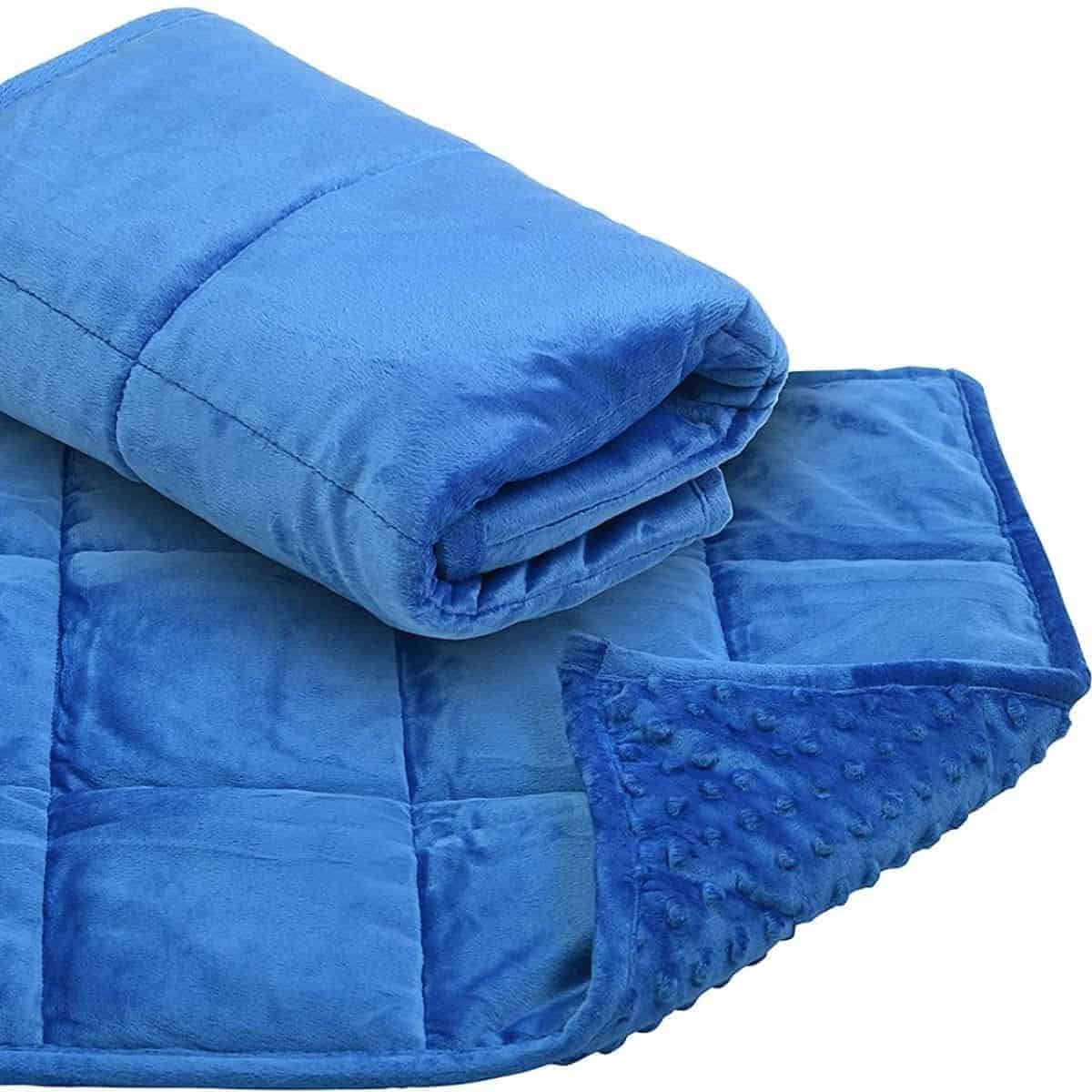
1. Basic Budget 3 lb Weighted Lap Pad – This is a great all around lap pad, and can be ordered in different weights. It’s also machine washable!
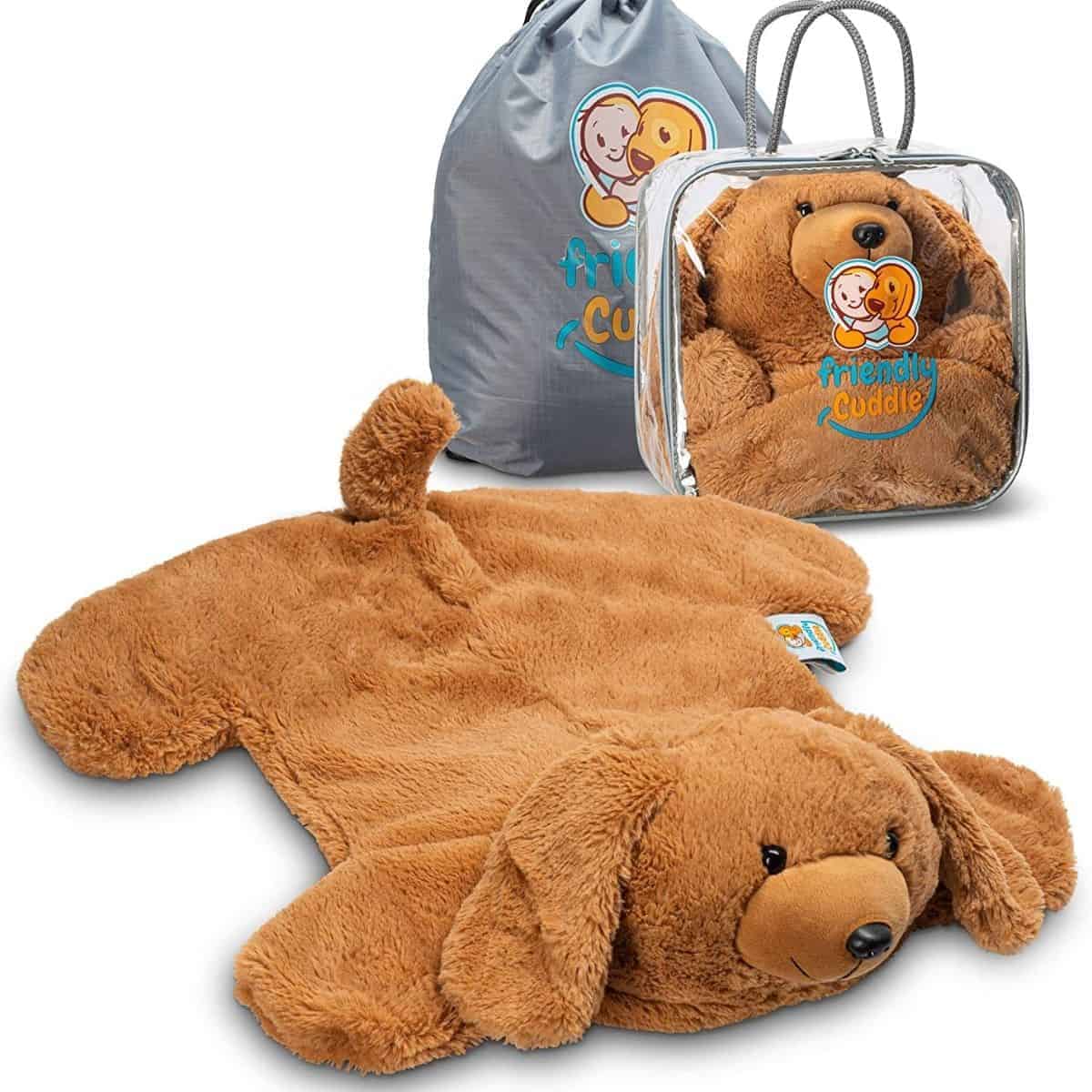
2. Cuddly Dog Weighted Lap Pad – I love this one because it looks like your child is just holding a fun stuffed animal on their lap. And, it has added sensory features by being able to ped the fur and play with the dogs ears!
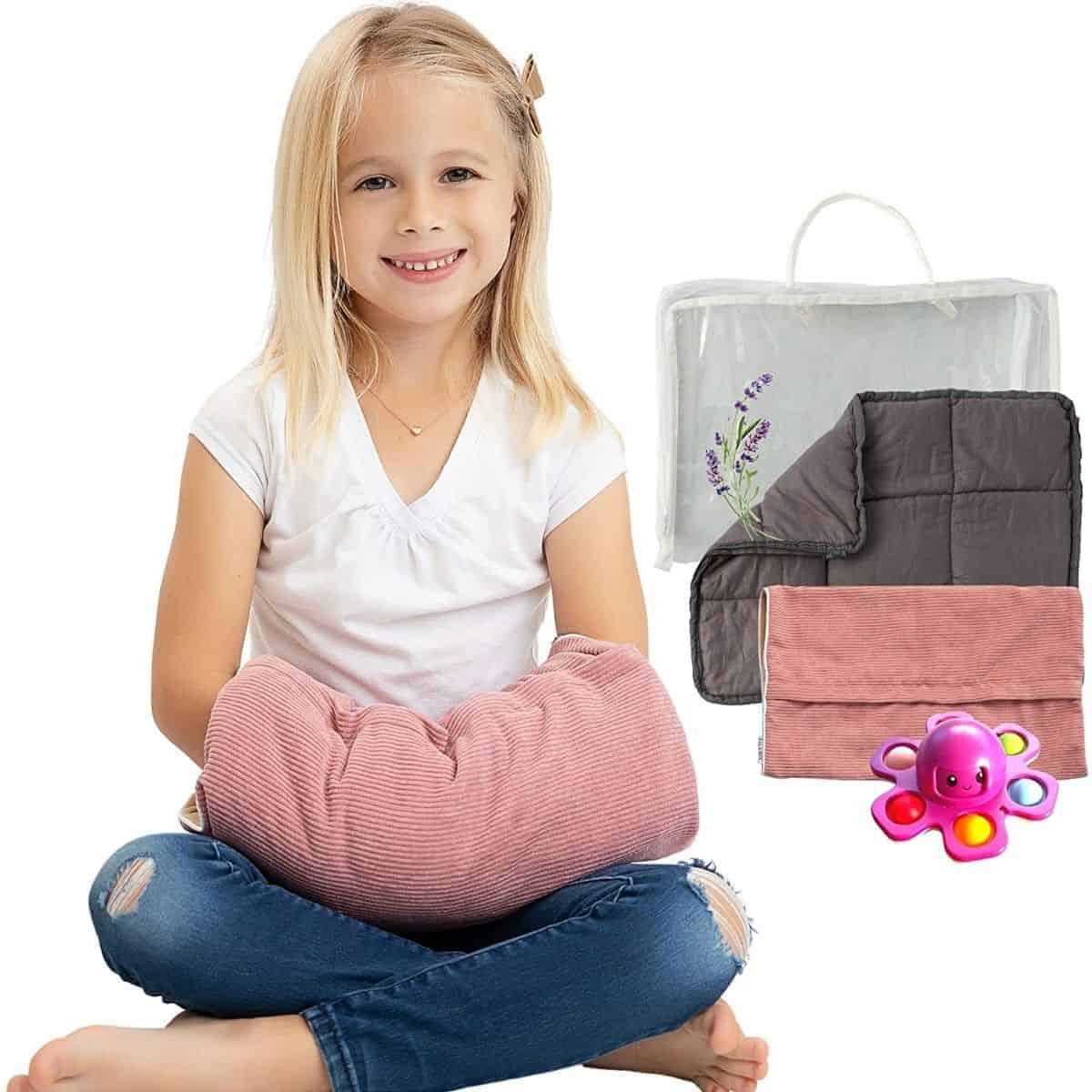
3. Heated and Scented Bolster Weighted Lap Pad – If your child likes warmth, this weighted lap pad is microwaveable, it’s also reversable for two different textures and has a fun bolster shape. And, it’s budget friendly!
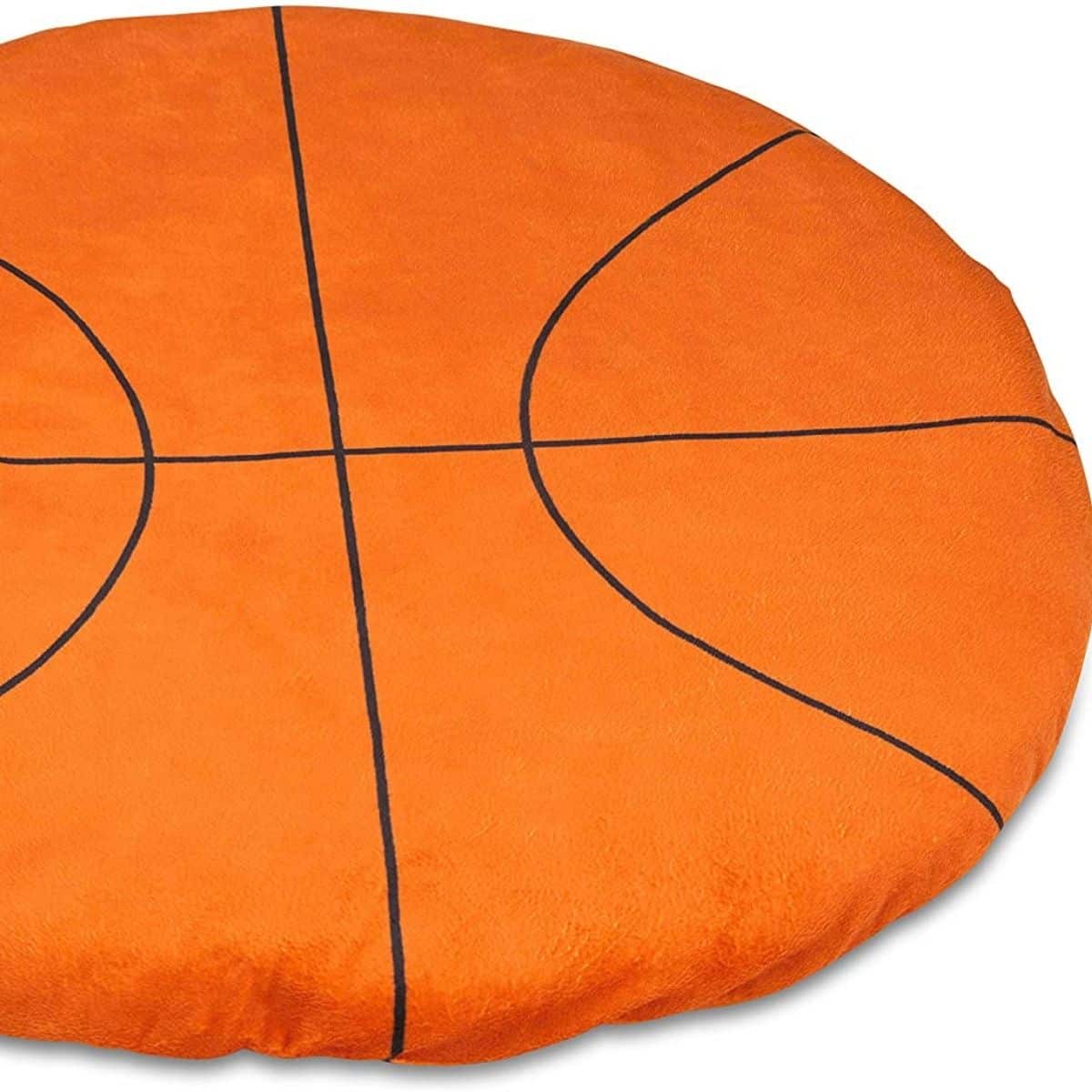
4. Basketball 5lb Weighted Lap Pad – Perfect for older kids, this pad will fly under the radar while giving that calming sensory input!
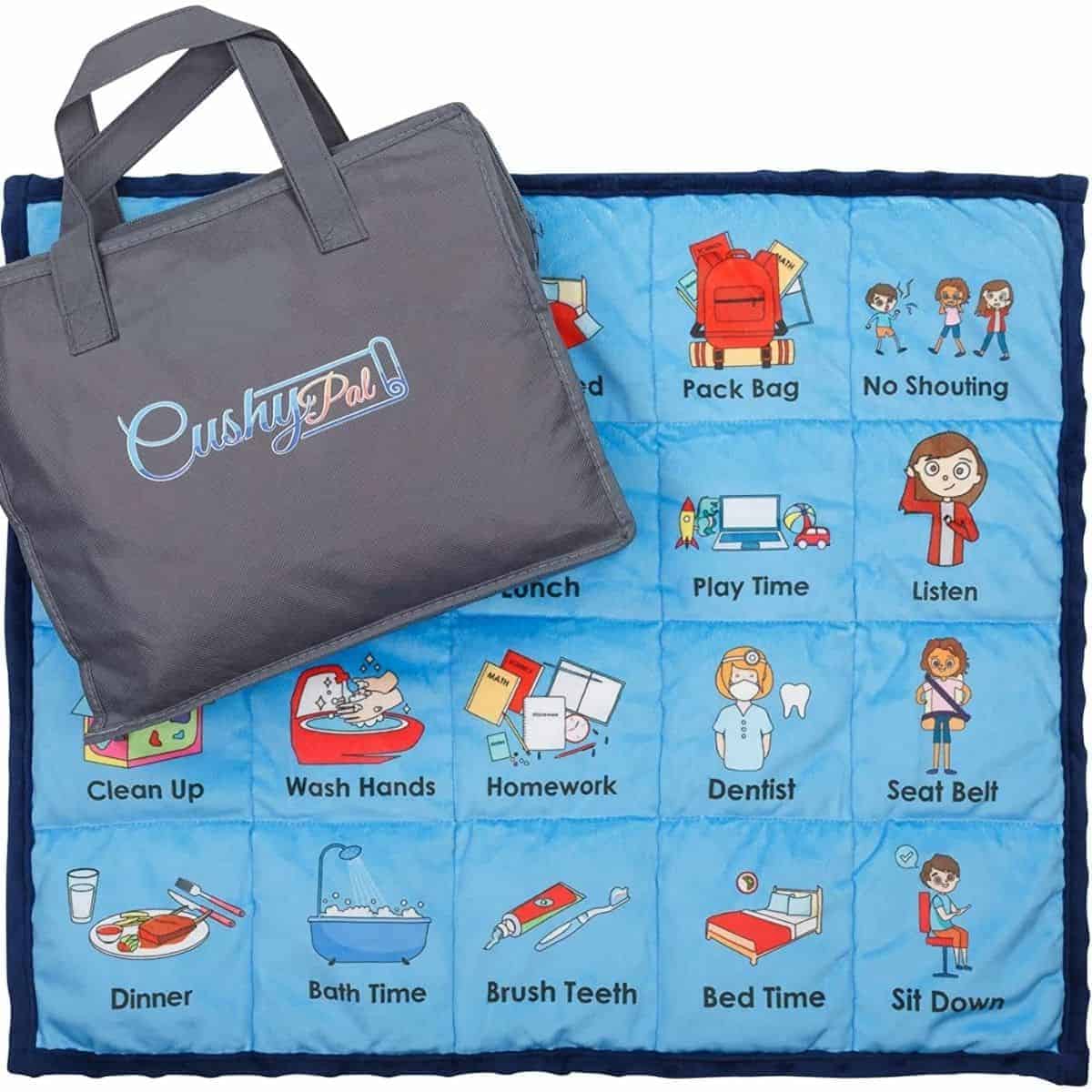
5. Daily Schedule Weighted Lap Pad – If your child is non-verbal or responds to schedules this weighted lap pad could serve multiple purposes!
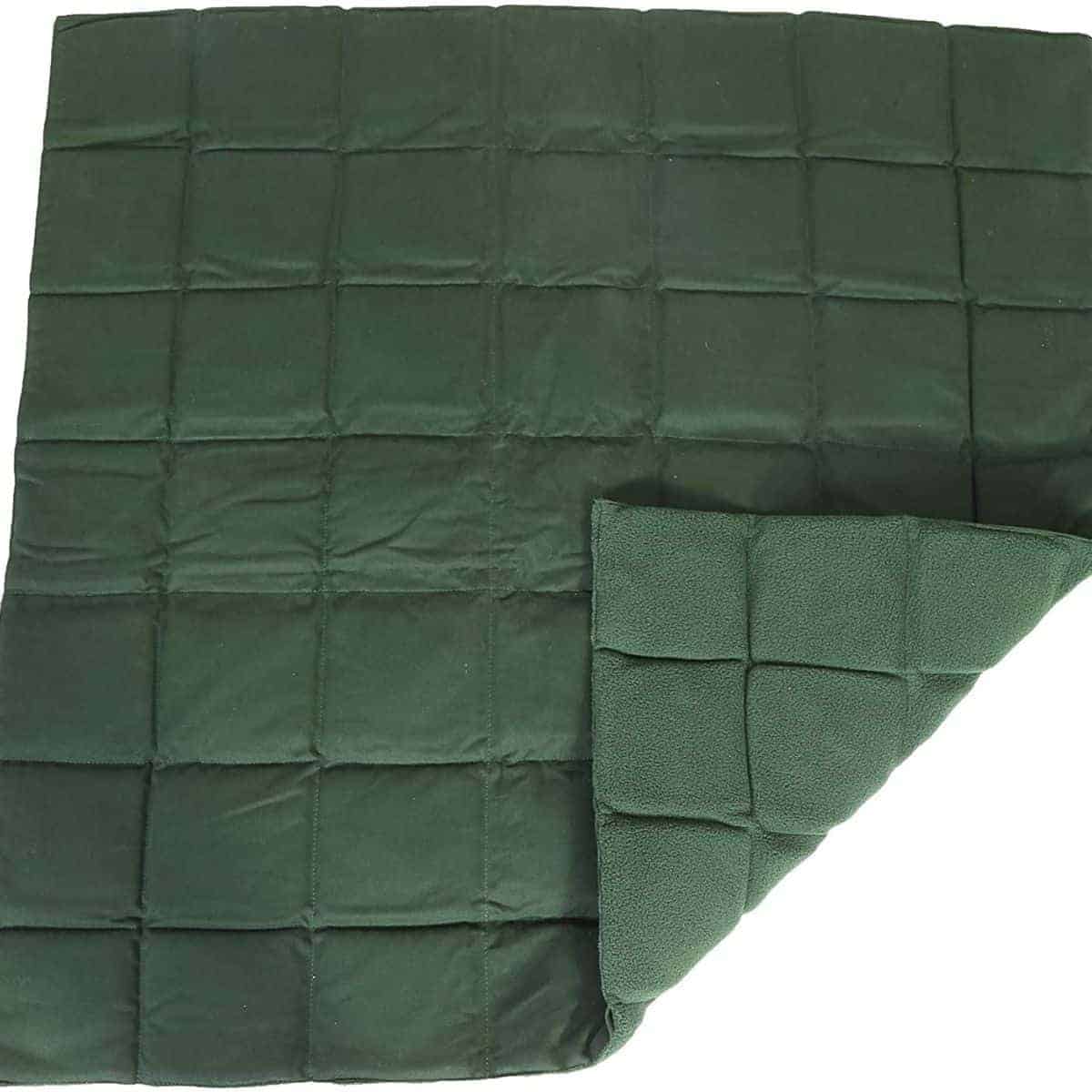
6. Jumbo Weighted Lap Pad – This is a larger and non-descript weighted lap pad. Perfect for kids 5 and older.
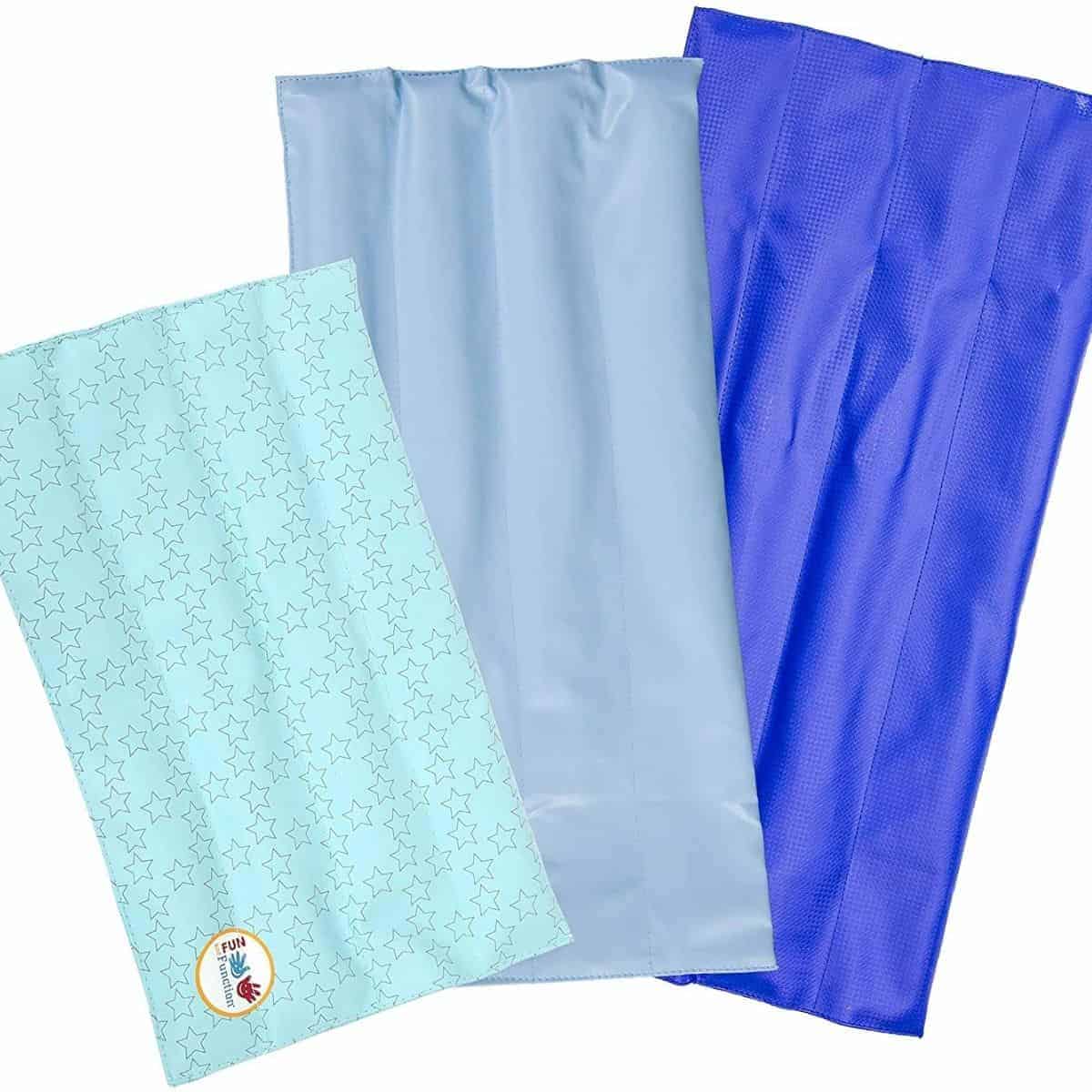
7. Wipe Clean Lap Pad – Also in three different weights, the awesome feature this lap pad holds is that it’s wipeable! Perfect for use at mealtimes or in the classroom.
DIY Weighted Lap Pads for Kids
I love DIY and putting something together myself, if you have the time these DIY versions might be a good fit for you:
1.Weighted “Snake” – Probably the easiest option, simply take an adult male’s large tube sock and fill it with dry beans, birdseed, rice, etc. Use a few rubber bands to tightly secure the end and close. Feel free to decorate!
2. Simple Hand Sew Washcloth Weighted Lap Pad – Learn how to use some needle and thread, two wash clothes, and two bags of beans to make a simple lap pad.
3. No-Sew Weighed Lap Pad with Sequin Fabric – All you need is some duct tape to close this baby up, they show you how in the video!
4. Stuffed animal weighted blanket – If you have some flat stuffed animals like a pillow pet, this is genius and incredibly simple!
Learn More About Using Sensory For Your Child
Whether using sensory tricks and hacks for your child is something new or old hat, sensory processing is a deep and often abstract topic for parents and even professionals. There’s a lot of cool activities, but some of them are time-consuming, some are expensive. And in no time, it can be easy for parents to get overwhelmed or confused.
I have a free workshop that I teach that walks you through 3 Expert Secrets to Calm and Focus Your Child with Specialized Sensory Activities.
In the workshop, I’ll uncover these secrets that can make like feel easier and less frustrating, as your child is finally able to calm down, focus, and much more.
More Sensory Tools and Tips for Kids
Did You Say Wobble Cushion? What it is & How it Works
5 Ways to Use a Scooter Board for Sensory Input
What is Sensory Integration Therapy, Does Your Child Need It?
13 Easy Sensory Strategies for the Classroom
Alisha Grogan is a licensed occupational therapist and founder of Your Kid’s Table. She has over 17 years experience with expertise in sensory processing and feeding development in babies, toddlers, and children. Alisha also has 3 boys of her own at home. Learn more about her here.
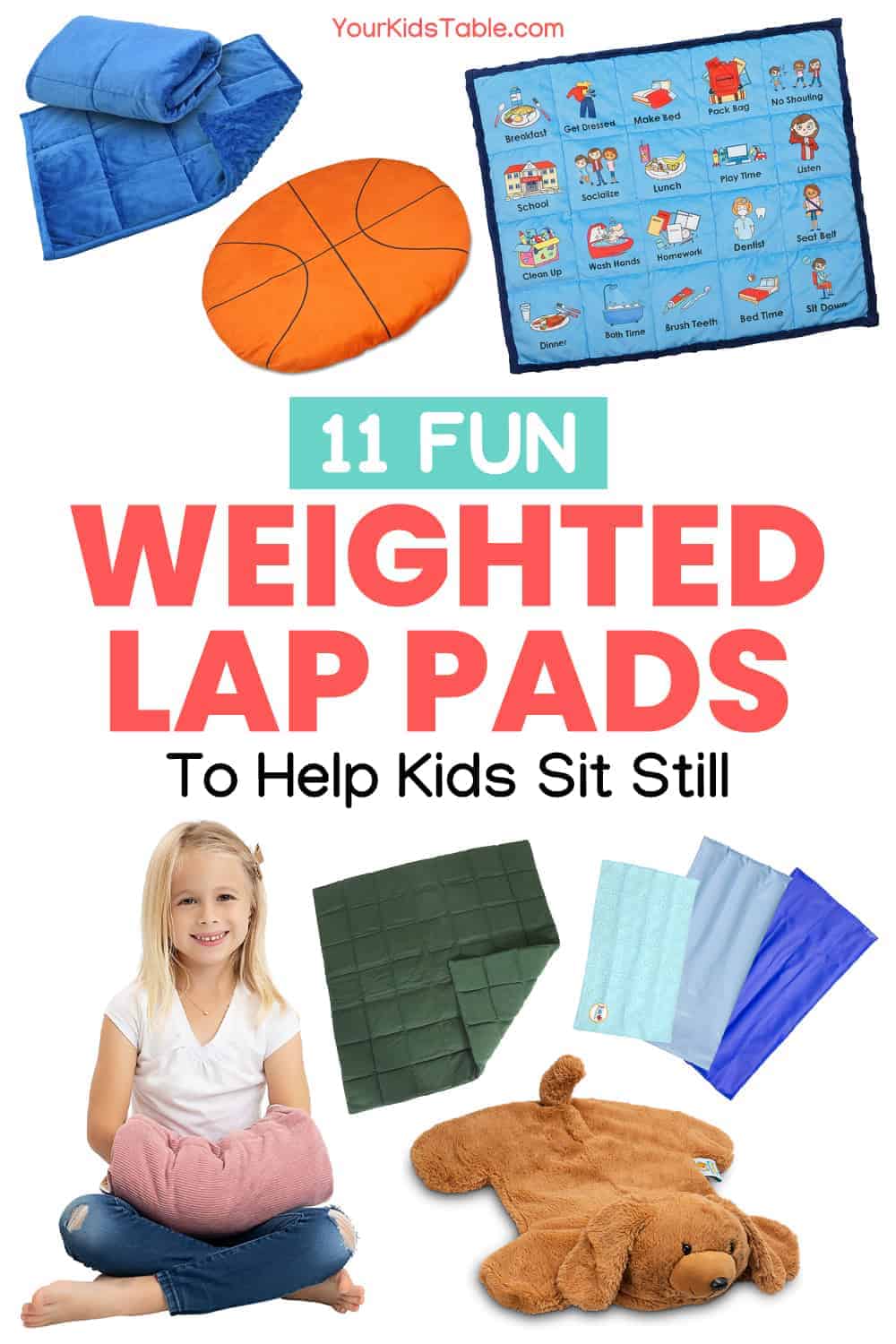
Great list! I never knew weighted lap pads could be so helpful for kids. I’m especially interested in the sensory benefits you mentioned. Can’t wait to try some of these with my little one!
Hello,
My 5 years old kids teacher recommended the pad today to help him sit still in class, I was doing some research about it and found your article. I was wondering is this tool only for kids with sensory troubles or adhd … or is it also for kids that are energetic but don’t necessarily have a particular issue ? Also if this blanket is put only in my child on a classroom wouldn’t that create some self esteem issues as he would view himself different from others in the classroom ? Thank you
Hi Meriem! These weighted lap pads would work well for all of the above! Kids with SPD, ADHD, or just very energetic kids that need some extra help sitting still. If youre concerned about how the other children in the classroom will react to your child wearing one, I’d recommend discussing it with your child’s teacher beforehand 🙂
Best,
Kalyn
Thank you Kalyn 😊
I love these weighted lap pads! They are so helpful for kids who struggle to sit still.
Hi Riya! Thanks for reaching out and sharing your thoughts! Lap pads are so fun and useful!
Best,
Kalyn
Please send me the article of the weighed
lap pad.
Hey,
Sorry if you are having trouble accessing the article. You can read it HERE
Best,
Desiree
IS there a way I can get a copy of this article without downloading all the advertisements?
Thankyou!